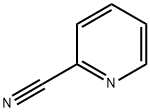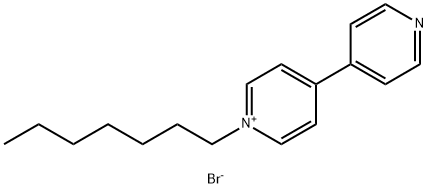1,1'-DI-N-HEPTYL-4,4'-BIPYRIDINIUM DIBROMIDE
Synonym(s):N ,N ′-Diheptyl-4,4′-dipyridylium dibromide;DHPB;Diheptylviologen bromide;Diheptylviologen dibromide;Heptylviologen dibromide
- CAS NO.:6159-05-3
- Empirical Formula: C24H38BrN2+
- Molecular Weight: 434.49
- MDL number: MFCD00011997
- EINECS: 228-178-7
- SAFETY DATA SHEET (SDS)
- Update Date: 2023-06-08 17:06:37

What is 1,1'-DI-N-HEPTYL-4,4'-BIPYRIDINIUM DIBROMIDE?
Chemical properties
yellow to yellow-green powder or flakes
The Uses of 1,1'-DI-N-HEPTYL-4,4'-BIPYRIDINIUM DIBROMIDE
DHBP is an EC material which can be used in the fabrication of electronic devices such as organic light emitting diodes (OLED), supercapacitors, and liquid crystal displays (LCDs).
What are the applications of Application
DHBP dibromide is a compound that blocks calcium release from sarcoplasmic reticulum
General Description
1,1′-Diheptyl-4,4′-bipyridinium dibromide (DHBP) is a heptyl viologen that can be used as an electrochromic (EC) material. It forms a highly efficient quenching system for conjugated polyelectrolyte for the development of organic electronics. It also acts as a redox active electrolyte for electrochemical devices (ECDs).
Biological Activity
Blocks calcium release from sarcoplasmic reticulum by direct interaction with the ryanodine receptor.
Properties of 1,1'-DI-N-HEPTYL-4,4'-BIPYRIDINIUM DIBROMIDE
| Melting point: | 285 °C (dec.) (lit.) |
| Density | 1.2527 (rough estimate) |
| refractive index | 1.6800 (estimate) |
| storage temp. | Inert atmosphere,Room Temperature |
| Water Solubility | Soluble in water |
| form | powder to crystal |
| color | Light yellow to Amber to Dark green |
| CAS DataBase Reference | 6159-05-3(CAS DataBase Reference) |
| EPA Substance Registry System | 4,4'-Bipyridinium, 1,1'-diheptyl-, dibromide (6159-05-3) |
Safety information for 1,1'-DI-N-HEPTYL-4,4'-BIPYRIDINIUM DIBROMIDE
| Signal word | Warning |
| Pictogram(s) |
 Exclamation Mark Irritant GHS07 |
| GHS Hazard Statements |
H315:Skin corrosion/irritation H319:Serious eye damage/eye irritation H320:Serious eye damage/eye irritation H335:Specific target organ toxicity, single exposure;Respiratory tract irritation |
| Precautionary Statement Codes |
P261:Avoid breathing dust/fume/gas/mist/vapours/spray. P264:Wash hands thoroughly after handling. P264:Wash skin thouroughly after handling. P305+P351+P338:IF IN EYES: Rinse cautiously with water for several minutes. Remove contact lenses, if present and easy to do. Continuerinsing. |
Computed Descriptors for 1,1'-DI-N-HEPTYL-4,4'-BIPYRIDINIUM DIBROMIDE
New Products
4-AMINO-TETRAHYDRO-PYRAN-4-CARBOXYLIC ACID HCL 4-(Dimethylamino)tetrahydro-2H-pyran-4-carbonitrile 4-Aminotetrahydropyran-4-carbonitrile Hydrochloride (R)-3-Aminobutanenitrile Hydrochloride 3-((Dimethylamino)methyl)-5-methylhexan-2-one oxalate 1,4-Dioxa-8-azaspiro[4.5]decane 5-Bromo-2-nitropyridine Nimesulide BP Aceclofenac IP/BP/EP Diclofenac Sodium IP/BP/EP/USP Mefenamic Acid IP/BP/EP/USP Ornidazole IP Diclofenac Potassium THOMAIND PAPER PH 2.0 TO 4.5 1 BOX BUFFER CAPSULE PH 9.2 - 10 CAP SODIUM CHLORIDE 0.1N CVS ALLOXAN MONOHYDRATE 98% PLATINUM 0.5% ON 3 MM ALUMINA PELLETS (TYPE 73) LITHIUM AAS SOLUTION 2-Bromo-1-(bromomethyl)-3-chloro-5-nitrobenzene 2-Bromo-3-nitroaniline N-(3-Hydroxypropyl)-N-methylacetamide 3-Bromo-6-chloropyridazine 4-ethyl-3-nitrobenzoic acidRelated products of tetrahydrofuran








You may like
-
![1,1'-Diheptyl-4,4'-bipyridinium Dibromide [for Electrochromic Material] CAS 6159-05-3](https://img.chemicalbook.in//Content/image/CP5.jpg) 1,1'-Diheptyl-4,4'-bipyridinium Dibromide [for Electrochromic Material] CAS 6159-05-3View Details
1,1'-Diheptyl-4,4'-bipyridinium Dibromide [for Electrochromic Material] CAS 6159-05-3View Details
6159-05-3 -
 1-Methyl-6-oxo-1,6-dihydropyridazine-3-carbonitrile 98%View Details
1-Methyl-6-oxo-1,6-dihydropyridazine-3-carbonitrile 98%View Details
99903-60-3 -
 1823368-42-8 98%View Details
1823368-42-8 98%View Details
1823368-42-8 -
 2-(3-(tert-butyl)phenoxy)-2-methylpropanoic acid 1307449-08-6 98%View Details
2-(3-(tert-butyl)phenoxy)-2-methylpropanoic acid 1307449-08-6 98%View Details
1307449-08-6 -
 Ethyl 3-(furan-2-yl)-3-hydroxypropanoate 25408-95-1 98%View Details
Ethyl 3-(furan-2-yl)-3-hydroxypropanoate 25408-95-1 98%View Details
25408-95-1 -
 2-Chloro-5-fluoro-1-methoxy-3-methylbenzene 98%View Details
2-Chloro-5-fluoro-1-methoxy-3-methylbenzene 98%View Details
1805639-70-6 -
 1784294-80-9 98%View Details
1784294-80-9 98%View Details
1784294-80-9 -
 Lithium ClavulanateView Details
Lithium ClavulanateView Details
61177-44-4
Statement: All products displayed on this website are only used for non medical purposes such as industrial applications or scientific research, and cannot be used for clinical diagnosis or treatment of humans or animals. They are not medicinal or edible.